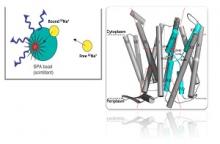- About us
- Research
- Students & Teaching
- Seminars & Events
- Directories
- Booking Rooms & Equipment
- עברית
Home » Prof. Padan presents new insights into the activity and importance of the carrier NhaA
Na+/H+ antiporters comprise a family of membrane proteins evolutionarily conserved in all kingdoms of life that are essential in cellular ion homeostasis. While several human homologues have long been drug targets, NhaA of Escherichia coli has become the paradigm for this class of secondary active transporters as NhaA crystals provided insight in the structure of this molecular machine. However, structural data revealing the composition of the binding site for Na+ (or its surrogate Li+) is missing, representing a bottleneck in our understanding of the correlation between the structure and function of NhaA.
By adapting the scintillation proximity assay (SPA) for direct determination of Na+ binding to NhaA, we revealed that
